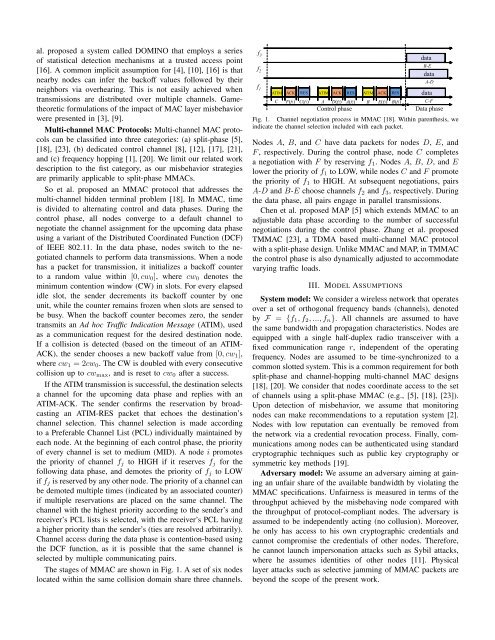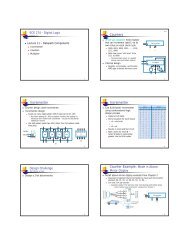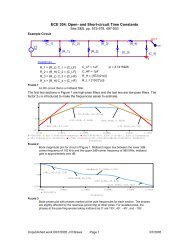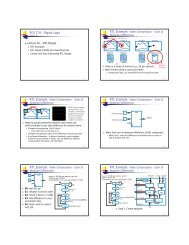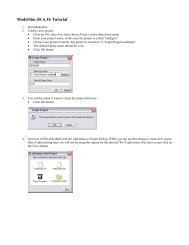Countering Selfish Misbehavior in Multi-channel MAC Protocols
Countering Selfish Misbehavior in Multi-channel MAC Protocols
Countering Selfish Misbehavior in Multi-channel MAC Protocols
Create successful ePaper yourself
Turn your PDF publications into a flip-book with our unique Google optimized e-Paper software.
al. proposed a system called DOMINO that employs a seriesof statistical detection mechanisms at a trusted access po<strong>in</strong>t[16]. A common implicit assumption for [4], [10], [16] is thatnearby nodes can <strong>in</strong>fer the backoff values followed by theirneighbors via overhear<strong>in</strong>g. This is not easily achieved whentransmissions are distributed over multiple <strong>channel</strong>s. Gametheoreticformulations of the impact of <strong>MAC</strong> layer misbehaviorwere presented <strong>in</strong> [3], [9].<strong>Multi</strong>-<strong>channel</strong> <strong>MAC</strong> <strong>Protocols</strong>: <strong>Multi</strong>-<strong>channel</strong> <strong>MAC</strong> protocolscan be classified <strong>in</strong>to three categories: (a) split-phase [5],[18], [23], (b) dedicated control <strong>channel</strong> [8], [12], [17], [21],and (c) frequency hopp<strong>in</strong>g [1], [20]. We limit our related workdescription to the fist category, as our misbehavior strategiesare primarily applicable to split-phase M<strong>MAC</strong>s.So et al. proposed an M<strong>MAC</strong> protocol that addresses themulti-<strong>channel</strong> hidden term<strong>in</strong>al problem [18]. In M<strong>MAC</strong>, timeis divided to alternat<strong>in</strong>g control and data phases. Dur<strong>in</strong>g thecontrol phase, all nodes converge to a default <strong>channel</strong> tonegotiate the <strong>channel</strong> assignment for the upcom<strong>in</strong>g data phaseus<strong>in</strong>g a variant of the Distributed Coord<strong>in</strong>ated Function (DCF)of IEEE 802.11. In the data phase, nodes switch to the negotiated<strong>channel</strong>s to perform data transmissions. When a nodehas a packet for transmission, it <strong>in</strong>itializes a backoff counterto a random value with<strong>in</strong> [0, cw 0 ], where cw 0 denotes them<strong>in</strong>imum contention w<strong>in</strong>dow (CW) <strong>in</strong> slots. For every elapsedidle slot, the sender decrements its backoff counter by oneunit, while the counter rema<strong>in</strong>s frozen when slots are sensed tobe busy. When the backoff counter becomes zero, the sendertransmits an Ad hoc Traffic Indication Message (ATIM), usedas a communication request for the desired dest<strong>in</strong>ation node.If a collision is detected (based on the timeout of an ATIM-ACK), the sender chooses a new backoff value from [0, cw 1 ],where cw 1 = 2cw 0 . The CW is doubled with every consecutivecollision up to cw max , and is reset to cw 0 after a success.If the ATIM transmission is successful, the dest<strong>in</strong>ation selectsa <strong>channel</strong> for the upcom<strong>in</strong>g data phase and replies with anATIM-ACK. The sender confirms the reservation by broadcast<strong>in</strong>gan ATIM-RES packet that echoes the dest<strong>in</strong>ation’s<strong>channel</strong> selection. This <strong>channel</strong> selection is made accord<strong>in</strong>gto a Preferable Channel List (PCL) <strong>in</strong>dividually ma<strong>in</strong>ta<strong>in</strong>ed byeach node. At the beg<strong>in</strong>n<strong>in</strong>g of each control phase, the priorityof every <strong>channel</strong> is set to medium (MID). A node i promotesthe priority of <strong>channel</strong> f j to HIGH if it reserves f j for thefollow<strong>in</strong>g data phase, and demotes the priority of f j to LOWif f j is reserved by any other node. The priority of a <strong>channel</strong> canbe demoted multiple times (<strong>in</strong>dicated by an associated counter)if multiple reservations are placed on the same <strong>channel</strong>. The<strong>channel</strong> with the highest priority accord<strong>in</strong>g to the sender’s andreceiver’s PCL lists is selected, with the receiver’s PCL hav<strong>in</strong>ga higher priority than the sender’s (ties are resolved arbitrarily).Channel access dur<strong>in</strong>g the data phase is contention-based us<strong>in</strong>gthe DCF function, as it is possible that the same <strong>channel</strong> isselected by multiple communicat<strong>in</strong>g pairs.The stages of M<strong>MAC</strong> are shown <strong>in</strong> Fig. 1. A set of six nodeslocated with<strong>in</strong> the same collision doma<strong>in</strong> share three <strong>channel</strong>s.f 3ACK RES ATIM ACK RES ATIM ACK RESf 2f 1ATIMC F(f1) C(f1) A D(f2) A(f2) B E(f3) B(f3)Control phasedataB-EdataA-DdataC-FData phaseFig. 1. Channel negotiation process <strong>in</strong> M<strong>MAC</strong> [18]. With<strong>in</strong> parenthesis, we<strong>in</strong>dicate the <strong>channel</strong> selection <strong>in</strong>cluded with each packet.Nodes A, B, and C have data packets for nodes D, E, andF , respectively. Dur<strong>in</strong>g the control phase, node C completesa negotiation with F by reserv<strong>in</strong>g f 1 . Nodes A, B, D, and Elower the priority of f 1 to LOW, while nodes C and F promotethe priority of f 1 to HIGH. At subsequent negotiations, pairsA-D and B-E choose <strong>channel</strong>s f 2 and f 3 , respectively. Dur<strong>in</strong>gthe data phase, all pairs engage <strong>in</strong> parallel transmissions.Chen et al. proposed MAP [5] which extends M<strong>MAC</strong> to anadjustable data phase accord<strong>in</strong>g to the number of successfulnegotiations dur<strong>in</strong>g the control phase. Zhang et al. proposedTM<strong>MAC</strong> [23], a TDMA based multi-<strong>channel</strong> <strong>MAC</strong> protocolwith a split-phase design. Unlike M<strong>MAC</strong> and MAP, <strong>in</strong> TM<strong>MAC</strong>the control phase is also dynamically adjusted to accommodatevary<strong>in</strong>g traffic loads.III. MODEL ASSUMPTIONSSystem model: We consider a wireless network that operatesover a set of orthogonal frequency bands (<strong>channel</strong>s), denotedby F = {f 1 , f 2 , ..., f n }. All <strong>channel</strong>s are assumed to havethe same bandwidth and propagation characteristics. Nodes areequipped with a s<strong>in</strong>gle half-duplex radio transceiver with afixed communication range r, <strong>in</strong>dependent of the operat<strong>in</strong>gfrequency. Nodes are assumed to be time-synchronized to acommon slotted system. This is a common requirement for bothsplit-phase and <strong>channel</strong>-hopp<strong>in</strong>g multi-<strong>channel</strong> <strong>MAC</strong> designs[18], [20]. We consider that nodes coord<strong>in</strong>ate access to the setof <strong>channel</strong>s us<strong>in</strong>g a split-phase M<strong>MAC</strong> (e.g., [5], [18], [23]).Upon detection of misbehavior, we assume that monitor<strong>in</strong>gnodes can make recommendations to a reputation system [2].Nodes with low reputation can eventually be removed fromthe network via a credential revocation process. F<strong>in</strong>ally, communicationsamong nodes can be authenticated us<strong>in</strong>g standardcryptographic techniques such as public key cryptography orsymmetric key methods [19].Adversary model: We assume an adversary aim<strong>in</strong>g at ga<strong>in</strong><strong>in</strong>gan unfair share of the available bandwidth by violat<strong>in</strong>g theM<strong>MAC</strong> specifications. Unfairness is measured <strong>in</strong> terms of thethroughput achieved by the misbehav<strong>in</strong>g node compared withthe throughput of protocol-compliant nodes. The adversary isassumed to be <strong>in</strong>dependently act<strong>in</strong>g (no collusion). Moreover,he only has access to his own cryptographic credentials andcannot compromise the credentials of other nodes. Therefore,he cannot launch impersonation attacks such as Sybil attacks,where he assumes identities of other nodes [11]. Physicallayer attacks such as selective jamm<strong>in</strong>g of M<strong>MAC</strong> packets arebeyond the scope of the present work.


